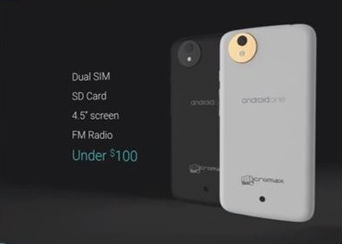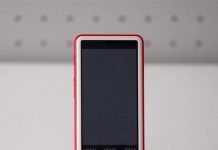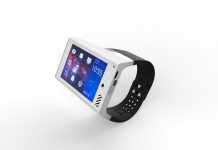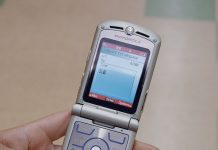 Fans of dirt-cheap e-reading devices – and who isn’t? – will be gladdened by one of the many announcements to come out of the Google I/O 2014 development conference, still under way in San Francisco. There, Google Android supremo Sundar Pichai introduced Android One, a new reference platform designed to bring an almost-full Android experience to users in emerging markets, with a sub-$100 price tag. According to the official Google Blog:
Fans of dirt-cheap e-reading devices – and who isn’t? – will be gladdened by one of the many announcements to come out of the Google I/O 2014 development conference, still under way in San Francisco. There, Google Android supremo Sundar Pichai introduced Android One, a new reference platform designed to bring an almost-full Android experience to users in emerging markets, with a sub-$100 price tag. According to the official Google Blog:
There are many people—billions of people, in fact—who still don’t have access to a smartphone. We want to change that; so today we announced an important initiative called Android One. We’re working with partners on a comprehensive solution—which includes hardware reference platforms—to address the mobile computing needs of those in emerging markets. Android One will provide smartphones that are high quality, affordable and come with reasonable data plans. Our partners will launch an initial range of sub-$100 Android One smartphones starting in India this Fall, with more countries to follow. We’ve long wondered what potential could be unleashed if people everywhere had access to the latest technology and the world’s information. It’s time to find out.
The new reference design has a 4.5″ screen, as well as emerging markets-friendly features like dual SIM slots, an SD card port, and an FM radio. Google’s plan is to extend a similar standardization and quality-proofing approach as its Google Play devices to the lower end of the market. One hardware partner already cited is Indian manufacturer Micromax. Other OEMs will presumably have the option to standardize on Android One or follow their own paths, but the platform already looks hard to resist.
The Android One reference design also parallels moves in other areas to rein in Android fragmentation, particularly the developer preview of the upcoming Android L iteration of the world’s most popular smartphone OS. Part and parcel of Android One on the software side, as well as a stock OS build, is automatic updates to the OS, making the endless wait for manufacturer-driven online upgrades a thing of the past – hopefully.
Will Android One devices start to appear in more developed markets? More than likely, I expect, given how porous modern market boundaries are, and that the European Union’s single market still contains some lower-income countries that would be ideal for Android One. At the very least, Android One should make it very hard for low-end devices to get away with anything less than a 4.5″ screen, making for a more comfortable smartphone e-reading experience all round.


































I don’t see how Android One is going to help bring cheaper Android devices to market. They already exist, and their biggest problem is that the hardware quality is frankly crap.
Take the Aakash, for example. The retail version costs $40, and it is terrible.
True enough, but those are tablets. Cell phones tend to cost a lot more than any equivalent tablet, because of that radio transceiver built into them I assume. The cheapest contract-free phone we’ve seen in the US is the $175 Moto G. (Which, oddly enough, was also developed by Google, or at least by Motorola while it was part of Google.) Most of them are in the $400 to $600 range unlocked. (Including the new Fire Phone.)
If they can get smartphones below $100, that’s a pretty big accomplishment. Of course, it’ll be hard to do anything with them in the USA for now, given that the carriers are being obstinate, but you never know…
It’s probably unbelievable, but there are people (possibly even a lot) who aren’t interested in owning smart phones. What price point would improve the experience of reading books on a tiny phone screen? What Google is interested in is Google and the opportunity to expand its tentacles into everyone’s lives. Nothing else.
@Catana, that’s a first world perspective. According to a recent UNESCO study, hundreds of thousands of people in developing countries are using cell phones to read. The Android One initiative could make that experience even better, assuming the price point is low enough.
Juli, well said. Catana, Third World citizens can download entire libraries for free *and* do life-enhancing mobile computing with smartphones. I’m sure that’d more than compensate for the absence of paper books they might never afford.
@Catana: Juli is on target about the UNESCO study, and that’s not all. Can anyone spell p-h-a-b-l-e-t? Even econo-smartphones will get bigger in the near future, and the screen resolutions will improve as well. I myself do a lot of my reading nowadays on a five-inch smartphone with better than 400 dpi resolution. The time will come when the screens of even throwaway phones are just as sharp.
One glory of even primitive smartphones is that you can carry them more easily than you can tablets. Smartphones can be with you almost always – just like your keys or your wallet or purse. Besides, here in the first world, people like to go back and forth between different devices, depending on their needs of the moment.
Also, remember the people in the US on the wrong side of the digital divide. Reading off a smartphone is a lot better than not being able to read e-books at all, especially the library variety if you’re cash-strapped.
What’s more, teenagers and other young people on the go could especially benefit from smartphones for recreational reading.
Some of my further thoughts on this topic are at http://librarycity.org/?p=10209.
I stand corrected on the usefulness of smart phones in areas where books and libraries are in short supply. But it would be a mistake to think that Google and other OEMs see it as anything but one more profitable market. Third-world markets start to be most heavily exploited when first-world markets are either saturated or over-competitive.